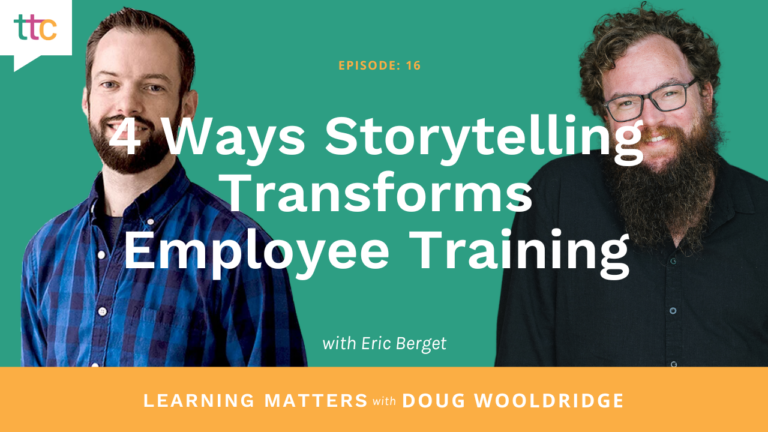If you’ve been living under a rock (or are a bit of a curmudgeon, like the author), you may not be on the crowdsourcing bandwagon for training strategies quite yet. If you’re resisting, it’s time to put your fears aside. Chances are, you’ve been crowdsourcing for your entire career, whether you know it or not.
The truth is that the concept of crowdsourcing is nothing new. It simply means getting information by enlisting the help of a large number of people. In other words, you want to know something, so you ask a bunch of people. While I’m pretty sure the idea goes back to cave dwellers, the word is new – “crowdsourcing”. And of course, the internet gives us the ability to ask a BUNCH of people.
So, when you’re working on eLearning content development where you can ask the trainees what they need to learn AND create an army of subject matter experts while you’re at it – well, why wouldn’t you?
Crowdsourcing is a way to get your ideas and content directly from the source and develop training that is more personal and relevant. Crowdsourcing is NOT a substitute for your training expertise and judgment, or a cure-all for your department. And it’s not the wild, wild west – unless you allow it to be.
Two Ways to Crowdsource
Before we get into the three basic steps of crowdsourcing, it’s important to note that crowdsourcing can take two forms:
Crowdsource your training topics: The Society of Human Resource Management has documented Boeing’s efforts to solicit ideas from their employee base. They provided employees with four categories of L&D investments. Then, they allowed them to vote on the ones that were most relevant and that they’d be likely to use. The result was an employee-driven shift away from instructor-led training and toward online courses. And we all know that workers are more likely to participate in anything – including training programs – when they’re given a voice.
- Crowdsource your content: From Videonitch: Typically an instructional designer would have to work closely with subject matter experts to create content. What if, instead, they utilized an online discussion forum and posed a simple question to the sales group like “What would you need to know to sell more product?” The information gained from the discussion threads would allow for the group to define the objectives of the content, and in some cases, create the content by sharing best practices.
Whether you’re looking for content or topics, the steps for crowdsourcing are the same – but the specifics can be a little different, as you’ll see below.
Step 1: Identify “The Crowd”
Before you can effectively crowdsource, you need to know who the crowd might be. In most cases, it’s not as simple as “every employee.” While you may want to send out some broad-based surveys (like the Boeing initiative above), it’s also possible that you want to have a narrower focus for your information-gathering. You might want to survey only engineers to find out which topics are relevant. Or only salespeople to see how they can best improve their numbers.
If you’re crowdsourcing content, it’s very important that you limit your “crowd” to specific Subject Matter Experts – you don’t want every Tom, Dick, and Harriet telling you how to perform a delicate engineering operation! In many cases, you’ll be able to find SMEs for specific content when you’re asking about training topics. Which leads us to . . .
Step 2: Gather Information
The best way to have your crowdsourcing efforts fall flat is to NOT have a good platform for feedback. According to hrdailyadvisor.com:
Anyone looking to crowdsource training should acquire or internally develop a platform that allows easy submission of content from the crowd as well as efficient content management and ease of access from those seeking information from the crowd. Improved technology continues to allow greater connectedness and efficiency within organizations. The potential for various business functions is immense, and training is no different.
So, the first step is making it easy for people to give you the information you need. Once you’re over that (not insubstantial) hurdle, you’ll need to decide what kind of information you’re looking for.
If you’re crowdsourcing topics, it’s a good idea to keep it simple. In the Boeing example, they gave their employees four choices with an option to add other ideas. Not only does a simpler approach make it easier for employees to respond, it also keeps everything in perspective – for them and you. With four questions, they’ll know they aren’t being given carte blanche to re-invent the company’s training department. And it allows you to highlight your expertise when it’s time to prioritize topics.
If you’re crowdsourcing information, there are two basic approaches. You can create a forum for conversation between a group of SMEs and sift through the results, or you can ask your SMEs to create the content directly. Either way, you’ll have the information you need and the ability to put it in a user-friendly, pedagogically-sound format.
Step 3: Curate and Validate
No matter how good the information you gather may be, it’s always your job to be sure your audience gets the right information in the right way. That’s why crowdsourcing can never replace you, the training professional. YOU are the real power behind effective crowdsourcing when you:
- Categorize and organize information.
- Match group preferences with business goals.
- Follow up on content – validate with management, other SMEs, etc.
- Edit and shape the content.
- Develop a sound educational plan.
Here is where we come in!
As content development connoisseurs we can help you put a plan in place to turn crowdsourced content into sound learning strategies with measurable results. Book a free call with us today to transform trainees into training solutions.
Crowdsourcing can help you develop an army of SMEs – but you’re still the general! When you open up to company employees – your eventual trainees – you’ll begin to develop meaningful, relevant, personalized training that will have a positive impact on your company now and in the future.







